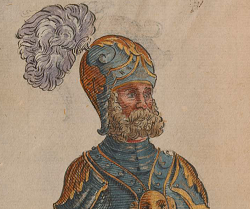|
|
You are not currently logged in. Are you accessing the unsecure (http) portal? Click here to switch to the secure portal. |
Wiktenauer:Main page/Featured
| Paulus Hector Mair | |
|---|---|
 "Mair", Cod.icon. 312b f 64r | |
| Born | 1517 Augsburg, Germany |
| Died | 10 Dec 1579 (age 62) Augsburg, Germany |
| Occupation |
|
| Movement | |
| Influences | |
| Genres | |
| Language | |
| Manuscript(s) |
|
| Concordance by | Michael Chidester |
| Signature | |
Paulus Hector Mair (Paulsen Hektor Mair, Paulus Hector Meyer; 1517 – 1579) was a 16th century German aristocrat, civil servant, and fencer. He was born in 1517 to a wealthy and influential Augsburg patrician family. In his youth, he likely received training in fencing and grappling from the masters of Augsburg fencing guild, and early on developed a deep fascination with fencing treatises. He began his civil service as a secretary to the Augsburg City Council; by 1541, Mair was the City Treasurer, and in 1545 he also took on the office of Master of Rations.
Mair's martial background is unknown, but as a citizen of a free city he would have had military obligations whenever the city went to war, and as a member of a patrician family he likely served in the cavalry. What is clear is that he was an avid collector of fencing treatises and other literature on military history. Like his contemporary Joachim Meÿer, Mair believed that the Medieval martial arts were being forgotten, which he saw as a tragedy, idealizing the arts of fencing as a civilizing and character-building influence on men. Where Meÿer sought to update the traditional fencing systems and apply them to contemporary weapons of war and defense, Mair was more interested in preserving historical teachings intact. Thus, some time in the latter part of the 1540s he commissioned what would become the most extensive compendium of German fencing treatises ever made, a massive two-volume manuscript compiling virtually every fencing treatise he could access. He retained famed artist Jörg Breu the Younger to create the illustrations for the text, and hired two Augsburg fencers to pose for the illustrations. This project was extraordinarily expensive and took at least four years to complete. Ultimately, three copies of this compendium were produced, each more extensive than the last; the first (MSS Dresden C.93/C.94) was written in Early New High German, the second and most artistically ambitious (Cod.icon. 393) in New Latin, and the third and final version (Cod. 10825/10826) incorporated both languages.
(Read more...)
